The Importance of Standardised Data-Collection Methods in the Improvement of Thermal Comfort Assessment Models for Developing Countries in the Tropics
Abstract
1. Introduction
2. Literature Review
2.1. Context of the Case Study
2.2. Thermal Comfort Assessment Models
2.3. The Problem
3. Methods
3.1. Fieldwork
3.1.1. Project One
3.1.2. Project Two
3.1.3. Project Three
3.1.4. Project Four
3.2. Data Collection Tools
3.3. Studied Variables
4. Results
4.1. Alternative Data-Collection Tools
4.2. Procedures
4.3. Data Analysis
5. Discussion and Conclusions
Author Contributions
Funding
Acknowledgments
Conflicts of Interest
References
- Edelman, A.; Gelding, A.; Elena McComiskie, R.K.; Penny, A.; Roberts, N.; Templeman, S.; Trewin, D.; Ziembicki, M.; Trewin, B.; Cortlet, R.; et al. State of the Tropics: 2014 Report. Available online: https://www.jcu.edu.au/state-of-the-tropics/publications/2014/2014-report/State-of-the-Tropics-2014-Full-Report.pdf (accessed on 21 March 2019).
- General Assembly of the United Nations. Report of the World Commission on Environment and Development: Our Common Future. Available online: https://sustainabledevelopment.un.org/content/documents/5987our-common-future.pdf (accessed on 21 March 2019).
- Riechmann, J. Desarrollo sostenible: La lucha por la interpretación. De la Econ. a la Ecologia 1995, 5, 1–20. [Google Scholar]
- Winner, L. The Whale and the Reactor: A Search for Limits in an Age of High Technology; University of Chicago Press: Chicago, IL, USA, 1988; ISBN 978-84-7432-280-4. [Google Scholar]
- Sivak, M. Potential energy demand for cooling in the 50 largest metropolitan areas of the world: Implications for developing countries. Energy Policy 2009, 37, 1382–1384. [Google Scholar] [CrossRef]
- Davis, L.W.; Gertler, P.J. Contribution of air conditioning adoption to future energy use under global warming. Proc. Natl. Acad. Sci. USA 2015, 112, 5962–5967. [Google Scholar] [CrossRef] [PubMed]
- The Japan Refrigeration and Air Conditioning Industry Association. World Air Conditioner Demand by Region. 2017. Available online: https://www.jraia.or.jp/english/World_AC_Demand.pdf (accessed on 23 March 2019).
- Yang, L.; Yan, H.; Lam, J.C. Thermal comfort and building energy consumption implications—A review. Appl. Energy 2014, 115, 164–173. [Google Scholar] [CrossRef]
- Yau, Y.H.; Hasbi, S. A review of climate change impacts on commercial buildings and their technical services in the tropics. Renew. Sustain. Energy Rev. 2013, 18, 430–441. [Google Scholar] [CrossRef]
- Zhao, H.X.; Magoulès, F. A review on the prediction of building energy consumption. Renew. Sustain. Energy Rev. 2012, 16, 3586–3592. [Google Scholar] [CrossRef]
- Pérez-Lombard, L.; Ortiz, J.; Pout, C. A review on buildings energy consumption. Energy Build. 2008, 40, 394–398. [Google Scholar] [CrossRef]
- Samson, J.; Berteaux, D.; Mcgill, B.J.; Humphries, M.M. Geographic disparities and moral hazards in the predicted impacts of climate change on human populations. Glob. Ecol. Biogeogr. 2011, 20, 532–544. [Google Scholar] [CrossRef]
- United Nations. Revision of World Population Prospects 2017. Available online: https://population.un.org/wpp/ (accessed on 23 March 2019).
- DANE, Departamento Administrativo Nacional de Estadistica. Resultados Preliminares del Censo Nacional de Población y Vivienda 2018. Available online: https://www.dane.gov.co/index.php/estadisticas-por-tema/demografia-y-poblacion/censo-nacional-de-poblacion-y-vivenda-2018 (accessed on 28 June 2019).
- Rodriguez, C.M.; D’alessandro, M. Climate and Context Adaptive Building Skins for Tropical Climates: A review centred on the context of Colombia. In Proceedings of the Conference: Advanced Building Skins, Bressanone, Italy, 28–29 October 2014. [Google Scholar]
- Secretaría Distrital de Ambiente. Resolucion 5926 de 2011; Secretaría Distrital de Ambiente: Cundinamarca, Colombia, 2011.
- Minvivienda. Resolucion No 0549; Minvivienda: Bogotá, Colombia, 2015.
- Olesen, B.W. International standards for the indoor environment. Indoor Air Suppl. 2004, 14, 18–26. [Google Scholar] [CrossRef]
- Fanger, P.O. Thermal Comfort; Danish Technical Press: Copenhagen, Denmark, 1970. [Google Scholar]
- De Dear, R.; Brager, G.; Cooper, D. Developing an adaptive model of thermal comfort and preference. ASHRAE Trans. 1997, 104, 1–18. [Google Scholar]
- Rupp, R.F.; Ghisi, E. What is the most adequate method to assess thermal comfort in hybrid commercial buildings located in hot-humid summer climate? Renew. Sustain. Energy Rev. 2014, 29, 449–462. [Google Scholar] [CrossRef]
- Kwong, Q.J.; Adam, N.M.; Sahari, B.B. Thermal comfort assessment and potential for energy efficiency enhancement in modern tropical buildings: A review. Energy Build. 2014, 68, 547–557. [Google Scholar] [CrossRef]
- Zain, Z.M.; Taib, M.N.; Baki, S.M.S. Hot and humid climate: Prospect for thermal comfort in residential building. Desalination 2007, 209, 261–268. [Google Scholar] [CrossRef]
- Karyono, T.H. Thermal Comfort in the Tropical South East Asia Region. Archit. Sci. Rev. 1996, 39, 135–139. [Google Scholar] [CrossRef]
- Zomorodian, Z.S.; Tahsildoost, M.; Hafezi, M. Thermal comfort in educational buildings: A review article. Renew. Sustain. Energy Rev. 2016, 59, 895–906. [Google Scholar] [CrossRef]
- Karjalainen, S. Thermal comfort and gender: A literature review. Indoor Air 2012, 22, 96–109. [Google Scholar] [CrossRef] [PubMed]
- Toe, D.H.C.; Kubota, T. Development of an adaptive thermal comfort equation for naturally ventilated buildings in hot-humid climates using ASHRAE RP-884 database. Front. Archit. Res. 2013, 2, 278–291. [Google Scholar] [CrossRef]
- Mishra, A.K.; Ramgopal, M. An adaptive thermal comfort model for the tropical climatic regions of India (Köppen climate type A). Build. Environ. 2015, 85, 134–143. [Google Scholar] [CrossRef]
- Oropeza-Perez, I.; Petzold-Rodriguez, A.H.; Bonilla-Lopez, C. Adaptive thermal comfort in the main Mexican climate conditions with and without passive cooling. Energy Build. 2017, 145, 251–258. [Google Scholar] [CrossRef]
- Cândido, C.; Lamberts, R.; de Dear, R.; Bittencourt, L.; de Vecchi, R. Towards a Brazilian standard for naturally ventilated buildings: Guidelines for thermal and air movement acceptability. Build. Res. Inf. 2011, 39, 145–153. [Google Scholar] [CrossRef]
- Yan, H.; Mao, Y.; Yang, L. Thermal adaptive models in the residential buildings in different climate zones of Eastern China. Energy Build. 2017, 141, 28–38. [Google Scholar] [CrossRef]
- Indraganti, M.; Ooka, R.; Rijal, H.B.; Brager, G.S. Adaptive model of thermal comfort for offices in hot and humid climates of India. Build. Environ. 2014, 74, 39–53. [Google Scholar] [CrossRef]
- Földváry Ličina, V.; Cheung, T.; Zhang, H.; de Dear, R.; Parkinson, T.; Arens, E.; Chun, C.; Schiavon, S.; Luo, M.; Brager, G.; et al. Development of the ASHRAE Global Thermal Comfort Database II. Build. Environ. 2018, 142, 502–512. [Google Scholar] [CrossRef]
- Roaf, S.; Nicol, F.; Humphreys, M.; Tuohy, P.; Boerstra, A. Twentieth century standards for thermal comfort: Promoting high energy buildings. Archit. Sci. Rev. 2010, 53, 65–77. [Google Scholar] [CrossRef]
- Merkel, A. Climate-Data.org. 2012. Available online: https://en.climate-data.org/ (accessed on 25 March 2019).
- ANSI/ASHRAE. ANSI/ASHRAE 55:2013 Thermal Environmental Conditions for Human Occupancy; ANSI/ASHRAE: New York, NY, USA, 2013. [Google Scholar]
- Shin, J.H. Toward a theory of environmental satisfaction and human comfort: A process-oriented and contextually sensitive theoretical framework. J. Environ. Psychol. 2016, 45, 11–21. [Google Scholar] [CrossRef]
- Rodriguez, C.; Medina, J.; Pinzon, A. Thermal Comfort and Satisfaction in the Context of Social Housing: Case Study in Bogotá, Colombia—Early view ©. J. Constr. Dev. Ctries 2019, 24, 1–25. [Google Scholar]
- ANSI/ASHRAE. ANSI/ASHRAE Standard 55-2017: Thermal Environmental Conditions for Human Occupancy; ANSI/ASHRAE: New York, NY, USA, 2017. [Google Scholar]
- Voiland, A. Why so many global temperature records? NASA Earth Obs. 2015. Available online: https://earthobservatory.nasa.gov/blogs/earthmatters/2015/01/21/why-so-many-global-temperature-records/ (accessed on 25 March 2019).
- Perini, K.; Magliocco, A. Effects of vegetation, urban density, building height, and atmospheric conditions on local temperatures and thermal comfort. Urban For. Urban Green. 2014, 13, 495–506. [Google Scholar] [CrossRef]
- Hoyt, T.; Schiavon, S.; Piccioli, A.; Cheung, T.; Moon, D.; Steinfeld, K. CBE Thermal Comfort Tool. Available online: http://comfort.cbe.berkeley.edu/ (accessed on 25 January 2019).
- Hong, S.H.; Gilbertson, J.; Oreszczyn, T.; Green, G.; Ridley, I. A field study of thermal comfort in low-income dwellings in England before and after energy efficient refurbishment. Build. Environ. 2009, 44. [Google Scholar] [CrossRef]
- Romanovsky, A.A. Skin temperature: Its role in thermoregulation. Acta Physiol. 2014. [CrossRef]

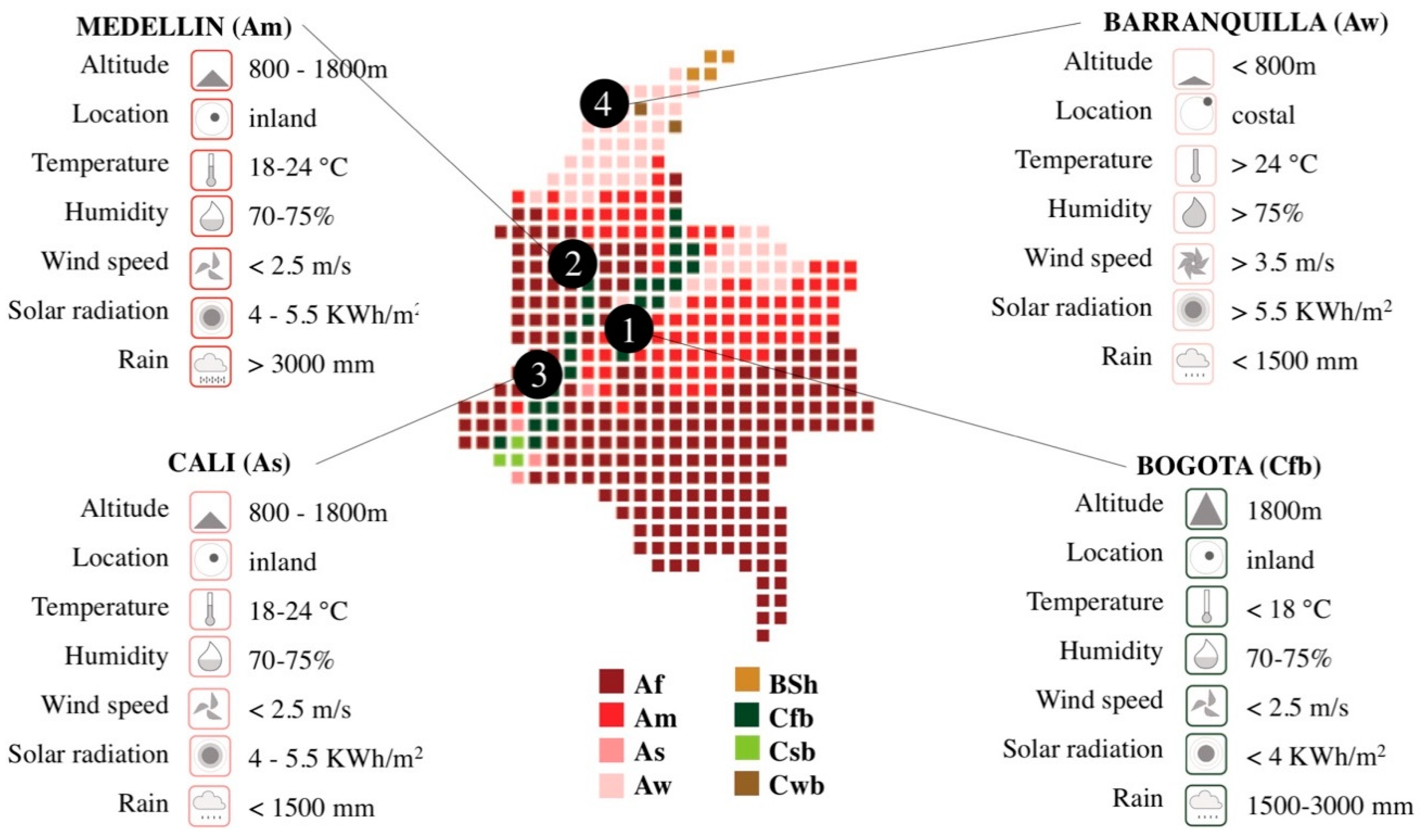
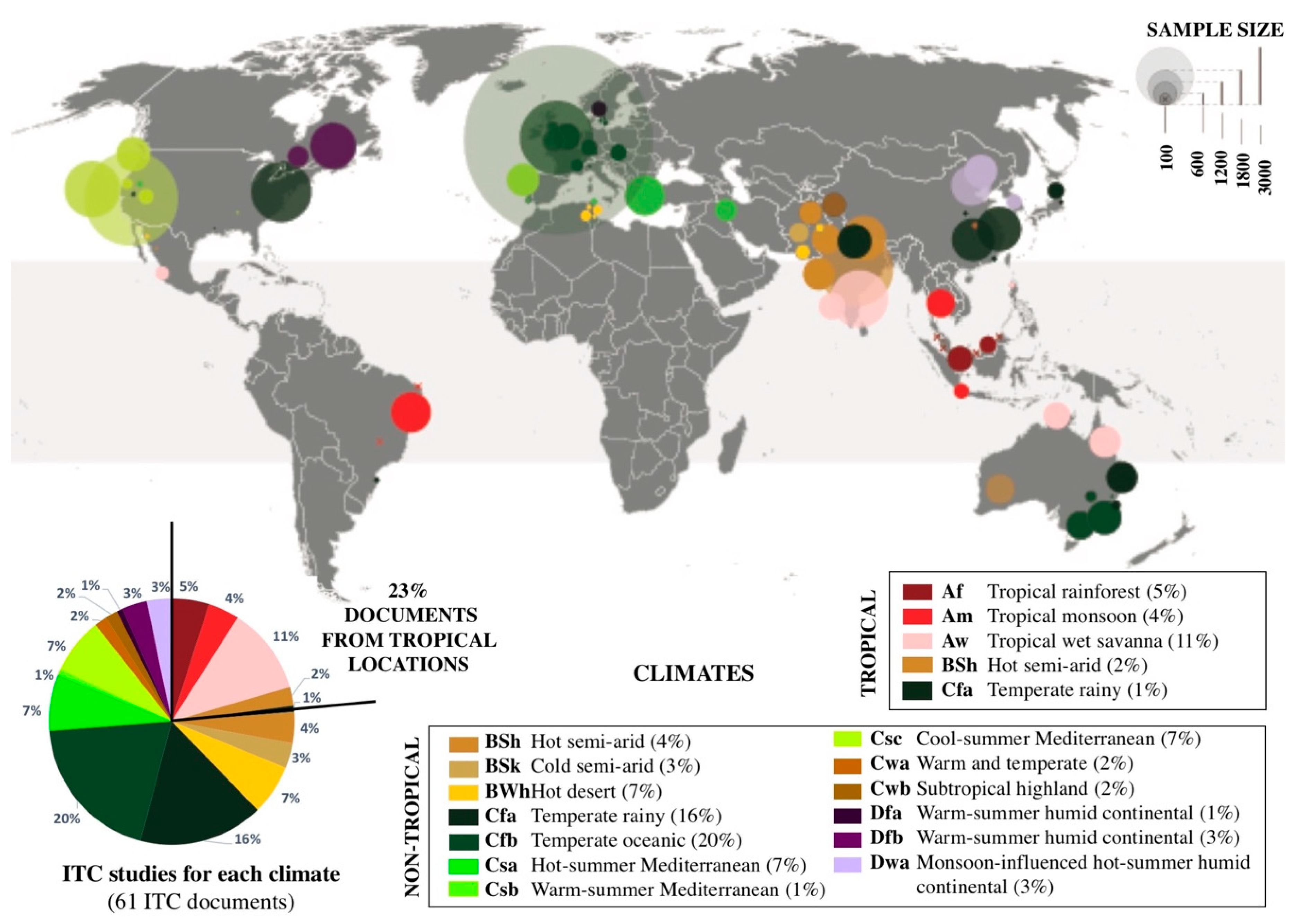



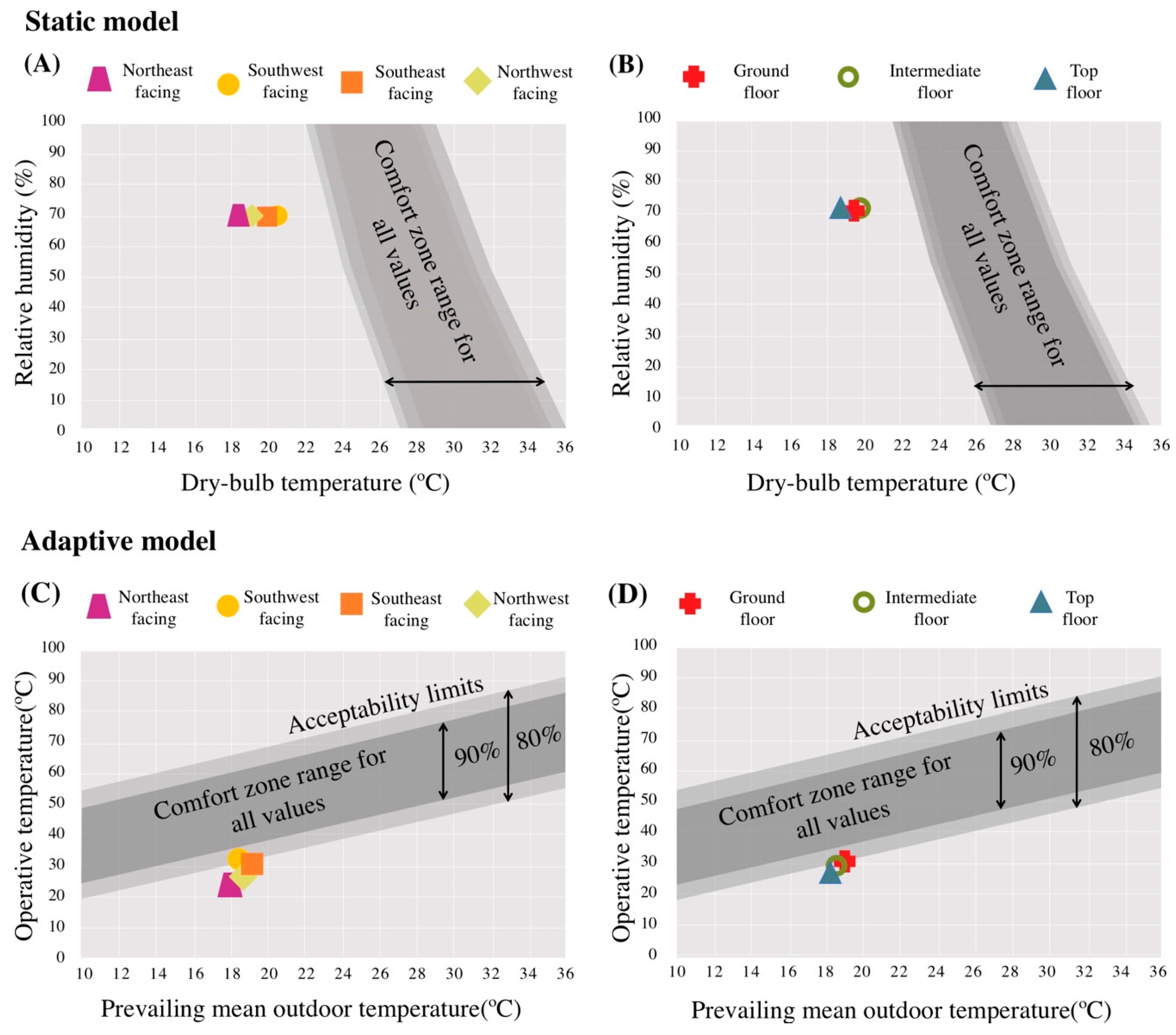

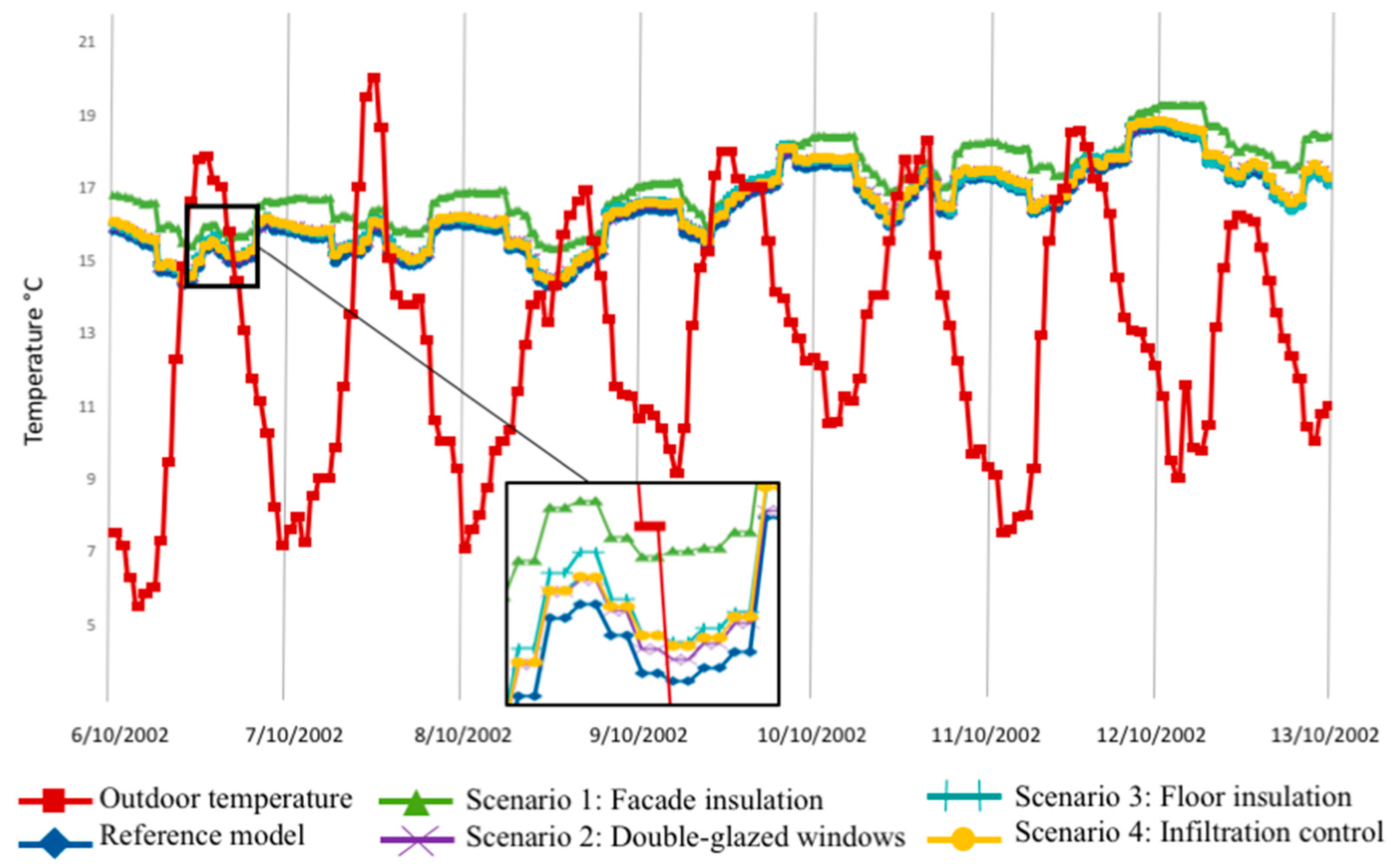
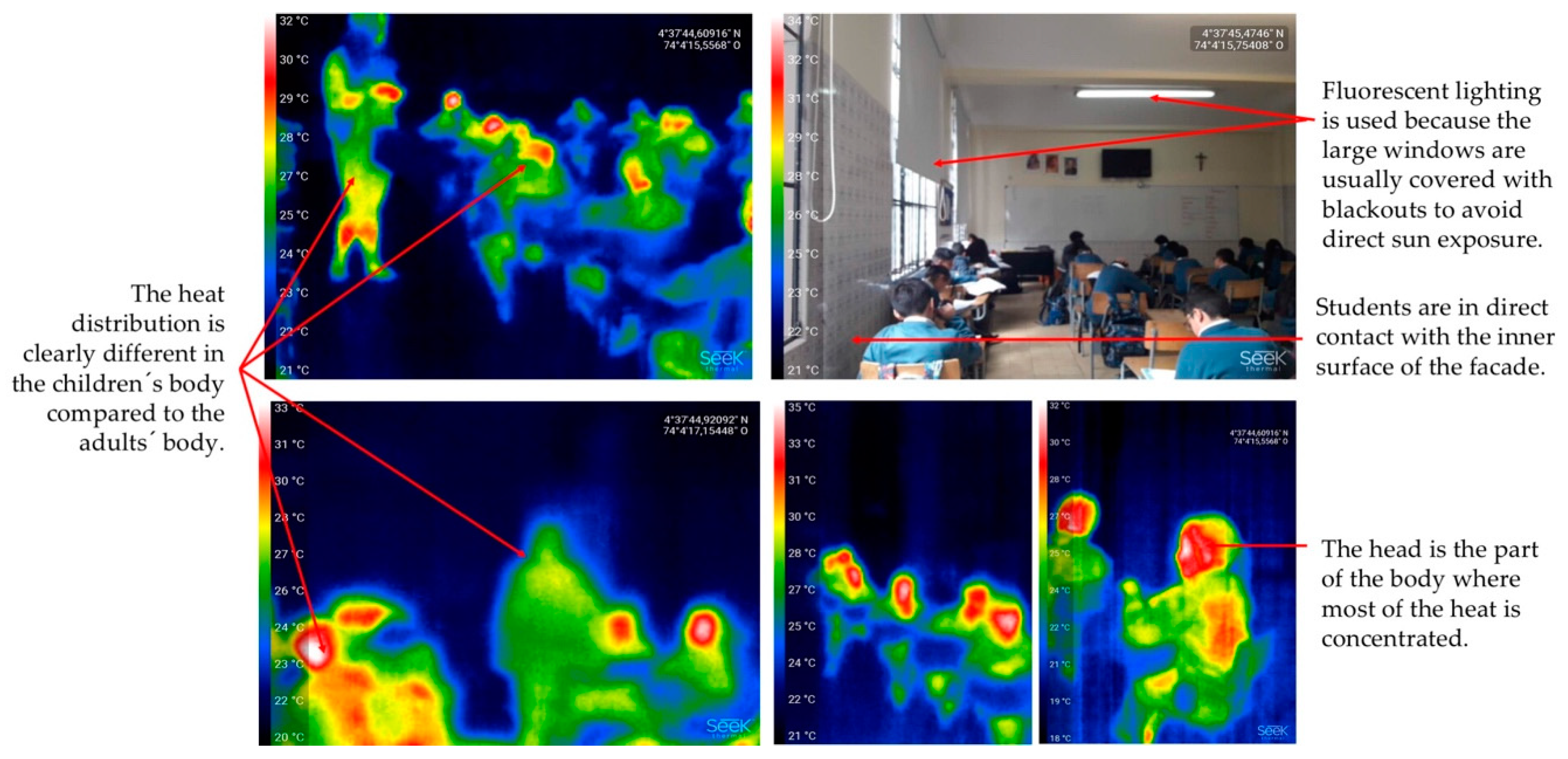
| Apartment Buildings | School Buildings | ||||
|---|---|---|---|---|---|
| Project One | Project Two | Project Three | Project Four | ||
| STUDY | Year of study | 2015–2016 | 2017 | 2018 | 2018 |
| Studied sample (units) | 44 | 28 | 12 | 8 | |
| Studied occupants | 44 | 28 | 166 | 168 | |
| BUILDING CHARACTERISTICS | Year of construction | 2014 | 1987 | The 1940s | The 1960s |
| No. storeys | 6 | 7 | 4 | 1 | |
| Ceiling height (m) | 2.3 | 2.3 | 3.7 | 3 | |
| Total Nº of units (apartments or classrooms) | 456 | 227 | 37 | 29 | |
| Total occupants (approx.) | 1368 | 681 | 1172 | 669 | |
| Occupants per unit (avg.) | 3 | 3 | 32 | 51 | |
| Average unit size (m2) | 70 | 63 | 62.5 | 72 | |
| CONSTRUCTION DETAILS | Building type | Block | Courtyard | Courtyard | Block |
| Wall construction | Concrete wall structure with a single-leaf brick wall facade, with no thermal insulation | Concrete and masonry wall structure with a single-leaf brick wall facade, with no thermal insulation | Concrete and masonry wall structure with a single-leaf brick wall facade with a stone finish or a double-leaf brick wall facade, both without thermal insulation | Concrete and masonry wall structure with a single-leaf brick wall facade, with no thermal insulation | |
| Wall thickness (m) | 0.13 | 0.25 | 0.35–0.5 | 0.25 | |
| Windows | Single-glassed aluminium-frame, featuring fixed top grills for ventilation. 4 mm glass. | Single-glassed aluminium-frame. 4–6 mm glass. | Single-glassed iron-frame, operable windows.4 mm glass. | Single-glassed aluminium-frame, featuring top small operable panes for ventilation. 5 mm glass. | |
| Used in Assessment Models | Recommended Equipment Criteria ASHRAE 55 | Equipment Used During the Case Study Projects | |||||
|---|---|---|---|---|---|---|---|
| Parameter | Static | Adaptive | Range | Accuracy | Instrument-Tool | Range | Accuracy |
| Dry-bulb air temperature (℃) | x | x | 10 to 40 °C (50 to 104 °F) | ±0.2 °C (0.4 °F) | Multi-channel Data Logger HOBO U12-012 | −20 to 70 °C (−4 to 158 °F) | ± 0.35 °C from 0 to 50 °C (± 0.63 °F from 32 to 122 °F) |
| Relative humidity (%) | x | 25% to 95% rh | ±5% rh | 5% to 95% | ± 2.5% rh from 10% to 90%, up to a maximum of ± 3.5% rh including hysteresis at 25 °C (77 °F); below 10% and above 90% ± 5% rh. | ||
| Globe temperature (°C) | x | x | Black globe thermometer Ø 150 mm | 10–40 °C | ±1 °C | ||
| Heat Index WBGT Meter Data Logger | 0 to 59 °C (32.0 to 138 °F) | ±1 °C | |||||
| Mean radiant temperature (°C) | x | x | 10 to 40 °C (50 to 104 °F) | ±1 °C (2 °F) | Derived from dry-bulb air temperature, globe temperature and airspeed | ||
| Operative temperature (°C) | x | x | Derived from dry-bulb air temperature, mean radiant temperature and airspeed | ||||
| Air speed (m/s) | x | x | 0.05 to 2 m/s (10 to 400 fpm) | ±0.05 m/s (±10 fpm) | T-DCI-F900-SO air velocity sensor | 0.15 to 10 m/s (30 to 1969 fpm) | +/−0.05 m/s |
| Plane radiant temperature (°C) | 0 to 50 °C (32 to 122 °F) | ±0.5 °C (1 °F) | Not measured | ||||
| Surface temperature (°C) | 0 to 50 °C (32 to 122 °F) | ±1 °C (2 °F) | Not measured | ||||
| Directional radiation (W/m2) | −35 to +35 W/m2 (−11 to +11 Btu/h·ft2) | ±5 W/m2 (±1.6 Btu/h·ft2) | Not measured | ||||
| Aspect to Evaluate | Sample Question | Limitations |
|---|---|---|
| Location of the space and the occupant | Place an “X” in the appropriate place where you spend most of your time (option of a map or a list of locations). | The answers for these questions tend to be very similar between the occupants of the same space. They experience comparable outdoor conditions, are normally dressed in equivalent clothing ensembles and the activity levels recorded are usually the same (light activity or seated answering the survey). The individualization of these questions did not report any substantial advantage regarding the general assessment of thermal comfort. In contrast, the time it took the occupants to answer these questions was considered a disadvantage. |
| On which floor of the building is the space located? | ||
| Are you near an exterior wall? | ||
| Are you near a window? | ||
| Approximate outdoor conditions | Record the approximate outside-air temperature and seasonal conditions: (space to indicate temperature and a list of seasons). | |
| Clothing insulation (clo) | Using the list below, please check each item of clothing that you are wearing right now (list of garments). | |
| Activity | What is your activity level right now? (List of options such as reclining, seated, standing relaxed, light activity, medium activity, high activity). | |
| Behaviour | Which of the following do you personally adjust in your space? (List of building components such as windows, heaters and thermostats). | This question was helpful to evaluate behaviour. However, it only contemplates environmental modifications to space and no other types of adaptive behaviour. |
| Sensation | What is your general thermal sensation? (7-point scale by the ASHRAE standard 55 going from −3 to +3: hot, warm, slightly warm, neutral, slightly cool, cool, cold). | The meaning of terms such as slightly or neutral was found to be different amongst occupants, especially when translated to Spanish. In some cases, neutral was linked to an attitude and was understood as thermal sensation being irrelevant. |
| Satisfaction | How satisfied are you with the temperature in your space? (From very satisfied to very dissatisfied). | Dissatisfaction with temperature is very often linked to discontent with other aspects of the space (e.g., ventilation, luminosity, humidity and noise). These are not considered in the recommended surveys. |
| If you are dissatisfied with the temperature in your space, which of the following contribute to your dissatisfaction: (list of options depending on the local climate). | ||
| Source of discomfort | How would you best describe the source of this discomfort? (List of options related to levels of humidity, air movement, sun exposure, drafts, operation of windows, conditioning systems and surrounding surfaces). | These questions were helpful to study perception. However, they only evaluate discomfort with temperature, overlooking other influential beliefs and expectations which play an important role when evaluating comfort. |
| Please describe any other issues related to being too hot or too cold in your space? |
| Tool | Aspect to Evaluate | Purpose-Outcome | Sample Questions/Information |
|---|---|---|---|
| SURVEYS Seven different surveys were designed according to the occupant’s characteristics (two for projects 1 and 2 and five for projects 3 and 4). All surveys were designed with the same structure to study seven different aspects. The language, graphics and complexity of the questions were adjusted to suit the occupants in each project. | Personal information | Information used to cross-reference different aspects against personal variables. | Blanks to fill in with information such as age, weight, height, gender and general health. (Optional section). |
| Evaluation | To evaluate the sensation of comfort and satisfaction regarding temperature, humidity, air movement and lighting. |
| |
| Perception | To evaluate causality, conduciveness and emotional response. To identify aspects that help or hinder the goal. |
| |
| Preference | To study the sense of value and expectation. |
| |
| Adaptive strategies | To study adaptive behaviour in four different aspects, according to [37]:
|
| |
| Physical-cognitive context | To establish points of reference and emotional response. |
| |
| Social context | To evaluate perceived control and agency and social or cultural preconceptions. |
| |
| LOGBOOK A template was designed using architectural drawings of the studied building. | Data and observations related to construction, occupants, survey and environmental measurements | To simplify the length of the surveys because many ordinal questions can be answered in the logbook by the observer instead of the participant. To uncover incidental issues that can influence the study of thermal comfort or have an impact on data collection. |
|
| FOCUS GROUP Fifteen-minute guided discussion with groups of 5–10 participants according to age. | Preconceptions, causality, conduciveness, perceptions, adaptive strategies, agency, expectations, common believes | To obtain personal feedback in a relaxed environment. To gain a better inside into cultural believes, common social practices, aspirations and desires. To explore other aspects of adaptive behaviour that are difficult to evaluate through the survey. |
|
| INTERVIEWS One-to-one meetings with selected people in each project. (e.g., administrative staff, building managers, owners or architects). | Evaluation, satisfaction control | To identify origins of discomfort or the stimuli behind the use of climatic conditioning. |
|
| AUDIO-VISUAL AIDS | Architecture and building detailing. Formal, functional and technical aspects of the space. Occupant’s behaviour | To complement the information gathered with other tools. To study aspects that are difficult to see with the naked eye such as heat distribution. To obtain further statistical data regarding energy consumption and the use of recourses. To contrast simulated scenarios against real conditions. |
|
© 2019 by the authors. Licensee MDPI, Basel, Switzerland. This article is an open access article distributed under the terms and conditions of the Creative Commons Attribution (CC BY) license (http://creativecommons.org/licenses/by/4.0/).
Share and Cite
Rodriguez, C.; Coronado, M.; D’Alessandro, M.; Medina, J. The Importance of Standardised Data-Collection Methods in the Improvement of Thermal Comfort Assessment Models for Developing Countries in the Tropics. Sustainability 2019, 11, 4180. https://doi.org/10.3390/su11154180
Rodriguez C, Coronado M, D’Alessandro M, Medina J. The Importance of Standardised Data-Collection Methods in the Improvement of Thermal Comfort Assessment Models for Developing Countries in the Tropics. Sustainability. 2019; 11(15):4180. https://doi.org/10.3390/su11154180
Chicago/Turabian StyleRodriguez, Carolina, María Coronado, Marta D’Alessandro, and Juan Medina. 2019. "The Importance of Standardised Data-Collection Methods in the Improvement of Thermal Comfort Assessment Models for Developing Countries in the Tropics" Sustainability 11, no. 15: 4180. https://doi.org/10.3390/su11154180
APA StyleRodriguez, C., Coronado, M., D’Alessandro, M., & Medina, J. (2019). The Importance of Standardised Data-Collection Methods in the Improvement of Thermal Comfort Assessment Models for Developing Countries in the Tropics. Sustainability, 11(15), 4180. https://doi.org/10.3390/su11154180





